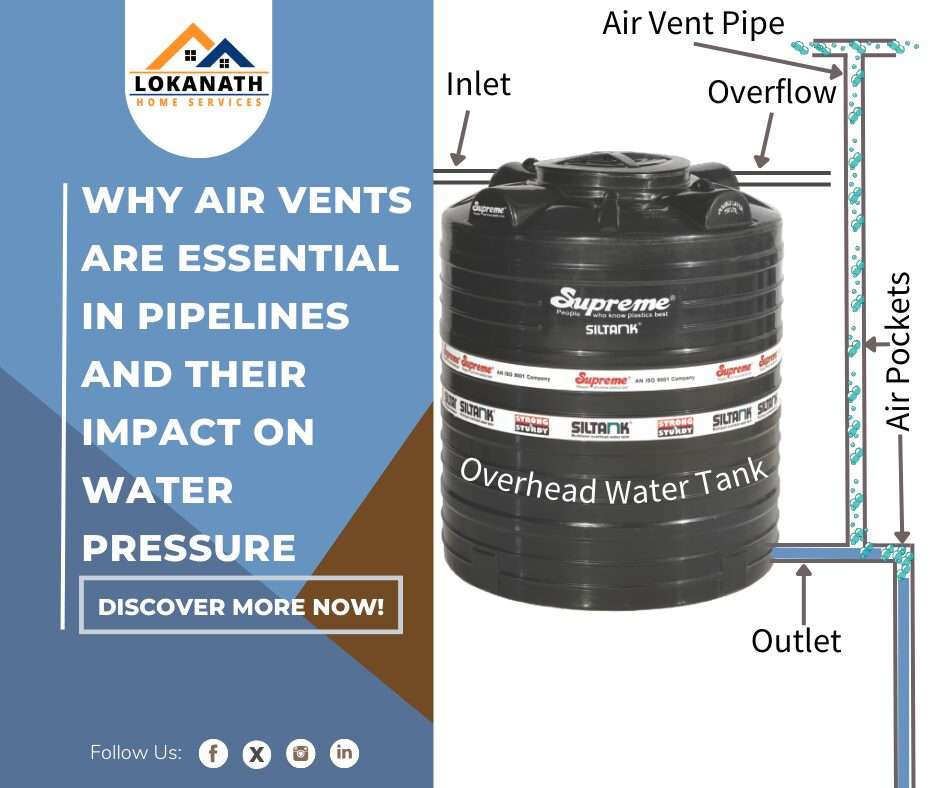Why Air Vents Are Essential in Pipelines and Their Impact on Water Pressure

Understanding the role of air vents in plumbing systems is crucial for maintaining efficient water flow and pressure. This blog will explore the benefits of using air vents in pipelines and how they influence water pressure, providing homeowners with valuable insights into optimizing their plumbing systems.
What Are Air Vents in Plumbing?
Definition and Purpose
Air vents, also known as air release valves, are essential components in plumbing systems. They allow trapped air to escape from pipelines, preventing airlocks and maintaining smooth water flow.
How Air Vents Work
Air vents are strategically placed at high points in a plumbing system. As water flows through the pipes, air bubbles naturally accumulate at these points. The air vent releases this trapped air, ensuring the pipeline remains full of water and operates efficiently.
Benefits of Using Air Vents in Pipelines
Preventing Airlocks
Airlocks can severely disrupt water flow, leading to inconsistent water pressure and potential damage to the plumbing system. By allowing trapped air to escape, air vents prevent these blockages and ensure a steady water supply.
Enhancing Water Pressure
Consistent water pressure is vital for the effective functioning of household appliances and fixtures. Air vents help maintain optimal water pressure by eliminating air pockets that can cause fluctuations. For more information on water pressure and how to adjust it, check out our detailed guide on what you need to know about water pressure and how to adjust it.
Reducing Corrosion
Trapped air can lead to oxidation and corrosion within pipes, shortening their lifespan. Air vents reduce the amount of trapped air, thereby minimizing the risk of corrosion and extending the durability of the plumbing system.
Improving Energy Efficiency
When airlocks cause uneven water pressure, pumps and other components have to work harder, consuming more energy. By maintaining consistent pressure, air vents contribute to the overall energy efficiency of the plumbing system.
Impact of Air Vents on Water Pressure
Maintaining Steady Flow
Air vents play a crucial role in maintaining a steady water flow. By removing air pockets, they ensure that water pressure remains consistent, which is essential for both daily use and emergency situations.
Preventing Pressure Build-Up
In some cases, trapped air can lead to excessive pressure build-up within the pipes, increasing the risk of bursts or leaks. Air vents help regulate pressure, protecting the integrity of the plumbing system.
Integrating Air Vents into Your Plumbing System
Professional Installation
For optimal performance, air vents should be installed by a professional plumber who can determine the best locations and ensure proper integration into the existing system. Find a certified plumber near you.
Regular Maintenance
Like any component of a plumbing system, air vents require regular maintenance to function effectively. Homeowners should schedule routine inspections and cleanings to keep their air vents in top condition. Learn more about plumbing maintenance.
Perfect Place to Install Air Vents in a Pipeline
The placement of air vents in your plumbing system is critical to their effectiveness. Ideally, air vents should be installed at high points in the pipeline where air naturally accumulates. This includes:
- At the Top of Vertical Risers: Vertical risers are common places for air to collect as it rises through the pipes. Installing air vents at the top of these risers allows the trapped air to escape easily.
- Near Pumps and Pressure Reducing Valves: These components can cause air to be introduced into the system. Placing air vents nearby ensures that any air entering the system is promptly released.
- At the End of Long Horizontal Runs: In long horizontal pipelines, air can become trapped over time. Installing air vents at the end of these runs helps in maintaining consistent water pressure throughout the pipeline.
- After Major Elevation Changes: When a pipeline goes through significant elevation changes, air can get trapped at the high points. Air vents should be installed at these high points to allow for the release of air.
- Near the Overhead Water Tank: The area near an overhead water tank is another critical point for air vent installation. As water is drawn from the tank, air can enter the system. Installing air vents near the tank ensures that this air is quickly and efficiently expelled, maintaining consistent water pressure and preventing potential airlocks.
Properly positioning air vents can significantly enhance the performance and longevity of your plumbing system. Consult with a professional plumber to determine the most effective locations for air vents in your specific setup. Learn more about the importance of proper air vent placement.
Air vents are invaluable for maintaining efficient and reliable plumbing systems. By preventing airlocks, enhancing water pressure, reducing corrosion, and improving energy efficiency, they play a critical role in the overall performance of your home's plumbing. For more detailed information on the benefits and installation of air vents, consult with our professional plumber and explore additional resources.

